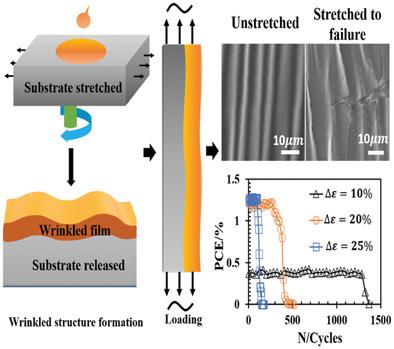当前位置:
X-MOL 学术
›
Macromol. Mater. Eng.
›
论文详情
Our official English website, www.x-mol.net, welcomes your
feedback! (Note: you will need to create a separate account there.)
Failure of Stretchable Organic Solar Cells under Monotonic and Cyclic Loading
Macromolecular Materials and Engineering ( IF 4.2 ) Pub Date : 2020-09-13 , DOI: 10.1002/mame.202000369 Oluwaseun Oyewole 1, 2 , Deborah Oyewole 2, 3 , Omolara Oyelade 4 , Sharafadeen Adeniji 4 , Richard Koech 1, 5 , Joseph Asare 6 , Benjamin Agyei‐Tuffour 7 , Winston Soboyejo 1, 2, 8
Macromolecular Materials and Engineering ( IF 4.2 ) Pub Date : 2020-09-13 , DOI: 10.1002/mame.202000369 Oluwaseun Oyewole 1, 2 , Deborah Oyewole 2, 3 , Omolara Oyelade 4 , Sharafadeen Adeniji 4 , Richard Koech 1, 5 , Joseph Asare 6 , Benjamin Agyei‐Tuffour 7 , Winston Soboyejo 1, 2, 8
Affiliation

|
Results of experimental and computational studies of failure of stretchable organic solar cells (SOSCs) are presented here. The SOSCs are produced by the deposition of poly(3,4‐ethylenedioxythiophene):polystyrene sulfonate (PEDOT:PSS) anodic layers on prestretched poly(dimethyl‐siloxane) (PDMS) substrates. This is followed by the deposition of active organic bulk heterojunction layers and cathodic eutectic gallium indium (EGaIn). Wrinkled structures are then formed by releasing the prestretched PDMS. The underlying failure associated with the formation of the wrinkled films is discussed, along with the subsequent mechanisms of deformation and cracking under monotonic and cyclic loading. Effects of monotonic and cyclic loading on the optical transmittance of the PEDOT:PSS layer and photoconversion efficiencies of the multilayered SOSC structures are also examined. An increase in the transmittance is observed as strain is applied to flatten the wrinkled structures. This enhances the power conversion efficiencies of the SOSCs as the strains increase from 0% to 32%. However, beyond this initial strain regime, the onset of overstretching decreases the optical transmittance and photoconversion efficiencies. The fatigue lifetimes of the layered SOSCs also decrease with increasing fatigue strain ranges between 10% and 25%. The decrease in the fatigue lifetimes is associated with a higher incidence of cracking and delamination.
中文翻译:

单调和循环载荷作用下可拉伸有机太阳能电池的失效
本文介绍了可拉伸有机太阳能电池(SOSC)失效的实验和计算研究结果。SOSC是通过在预拉伸的聚(二甲基硅氧烷)(PDMS)基材上沉积聚(3,4-乙烯二氧噻吩):聚苯乙烯磺酸盐(PEDOT:PSS)阳极层而产生的。接下来是沉积活性有机体异质结层和阴极共晶镓铟(EGaIn)。然后通过释放预拉伸的PDMS形成起皱的结构。讨论了与皱纹膜的形成有关的潜在破坏,以及在单调和循环载荷下变形和开裂的后续机理。单调和循环载荷对PEDOT光学透射率的影响:还检查了多层SOSC结构的PSS层和光转换效率。当施加应变以使皱纹结构变平时,观察到透射率增加。随着应变从0%增加到32%,这可以提高SOSC的功率转换效率。然而,超出该初始应变范围,过度拉伸的开始降低了光透射率和光转换效率。层状SOSC的疲劳寿命也会随着疲劳应变范围在10%到25%之间的增加而降低。疲劳寿命的降低与裂纹和分层的发生率更高有关。随着应变从0%增加到32%,这可以提高SOSC的功率转换效率。然而,超出该初始应变范围,过度拉伸的开始降低了光透射率和光转换效率。层状SOSC的疲劳寿命也会随着疲劳应变范围在10%到25%之间的增加而降低。疲劳寿命的降低与裂纹和分层的发生率更高有关。随着应变从0%增加到32%,这可以提高SOSC的功率转换效率。然而,超出该初始应变范围,过度拉伸的开始降低了光透射率和光转换效率。层状SOSC的疲劳寿命也会随着疲劳应变范围在10%到25%之间的增加而降低。疲劳寿命的降低与裂纹和分层的发生率更高有关。
更新日期:2020-11-16
中文翻译:

单调和循环载荷作用下可拉伸有机太阳能电池的失效
本文介绍了可拉伸有机太阳能电池(SOSC)失效的实验和计算研究结果。SOSC是通过在预拉伸的聚(二甲基硅氧烷)(PDMS)基材上沉积聚(3,4-乙烯二氧噻吩):聚苯乙烯磺酸盐(PEDOT:PSS)阳极层而产生的。接下来是沉积活性有机体异质结层和阴极共晶镓铟(EGaIn)。然后通过释放预拉伸的PDMS形成起皱的结构。讨论了与皱纹膜的形成有关的潜在破坏,以及在单调和循环载荷下变形和开裂的后续机理。单调和循环载荷对PEDOT光学透射率的影响:还检查了多层SOSC结构的PSS层和光转换效率。当施加应变以使皱纹结构变平时,观察到透射率增加。随着应变从0%增加到32%,这可以提高SOSC的功率转换效率。然而,超出该初始应变范围,过度拉伸的开始降低了光透射率和光转换效率。层状SOSC的疲劳寿命也会随着疲劳应变范围在10%到25%之间的增加而降低。疲劳寿命的降低与裂纹和分层的发生率更高有关。随着应变从0%增加到32%,这可以提高SOSC的功率转换效率。然而,超出该初始应变范围,过度拉伸的开始降低了光透射率和光转换效率。层状SOSC的疲劳寿命也会随着疲劳应变范围在10%到25%之间的增加而降低。疲劳寿命的降低与裂纹和分层的发生率更高有关。随着应变从0%增加到32%,这可以提高SOSC的功率转换效率。然而,超出该初始应变范围,过度拉伸的开始降低了光透射率和光转换效率。层状SOSC的疲劳寿命也会随着疲劳应变范围在10%到25%之间的增加而降低。疲劳寿命的降低与裂纹和分层的发生率更高有关。









































 京公网安备 11010802027423号
京公网安备 11010802027423号